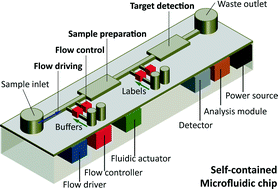Self-contained microfluidic systems: a review
Abstract
Microfluidic systems enable rapid diagnosis, screening and monitoring of diseases and health conditions using small amounts of biological samples and reagents. Despite these remarkable features, conventional microfluidic systems rely on bulky expensive external equipment, which hinders their utility as powerful analysis tools outside of research laboratories. ‘Self-contained’ microfluidic systems, which contain all necessary components to facilitate a complete assay, have been developed to address this limitation. In this review, we provide an in-depth overview of self-contained microfluidic systems. We categorise these systems based on their operating mechanisms into three major groups: passive, hand-powered and active. Several examples are provided to discuss the structure, capabilities and shortcomings of each group. In particular, we discuss the self-contained microfluidic systems enabled by active mechanisms, due to their unique capability for running multi-step and highly controllable diagnostic assays. Integration of self-contained microfluidic systems with the image acquisition and processing capabilities of smartphones, especially those equipped with accessory optical components, enables highly sensitive and quantitative assays, which are discussed. Finally, the future trends and possible solutions to expand the versatility of self-contained, stand-alone microfluidic platforms are outlined.


 Please wait while we load your content...
Please wait while we load your content...